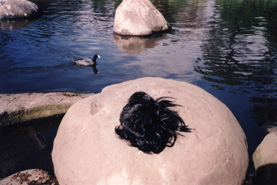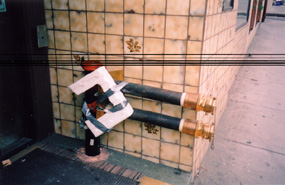The Rat Papers

Before I start I just want to say that right now I feel like a werewolf that’s woken up completely discombobulated in a pasture one foggy spring morning, staring straight up into the sky with the sound of fog horns in my ears.
I’ve been thinking about and experimenting with ideas surrounding two of Marcel Duchamp’s creations for a long time. One is the idea of the infra-mince he came up with in 1937 and the other is a small, assisted readymade object from 1916 called “A Bruit Secret (with hidden noise).” I am also interested in this notion of John Cage’s about not really liking to listen to records but liking to encounter the sound of recorded music when walking down the street as it flows out of open windows or from passing cars. To him, it has that strange quality of a rendezvous. In producing my own videos and compiling shows for ATV (ATA’s weekly cable access show) and taking photographs and working collaboratively, I feel like I’m really trying to get to that point where I just live my life. If it so happens that things end up having the quality of a rendezous, like encountering sounds coming out of a window, then that’s great.
when the viewer recognizes the title of the song, the song starts up in their head
 |
2003, Duck Wig |
I think it’s much more interesting to experience a rendezvous than to try to control things. Life becomes much more contingent and relative. When I view the photographs I get this strange sensation of seeing myself in this interval or moment or void or lapse through someone else’s eyes. This approach allows me to see all of the many intervals and infra-mince episodes and brief, unexplainable moments in my daily life. I feel much more open to shooting photographs of contingent moments when it pleases me. I don’t have to have topics or a signature style to chase. I don’t have to follow any set rule or narrative or.melodrama. I don’t really think like a photographer in any shape or form really. Most of the time I feel like a cartoon character that is a television producer—which is perfectly fine with me.
I love the dialectical materialism of the ontological inbetweenness of television waves beaming around the earth and knowing that individuals that you don’t even know are watching the show. I work for Project Open Hand in San Francisco and I go into some of the most rat-infested, skanky residential hotels in the city. For many of these bed-ridden clients the only connection to anything outside of this reality is through the television. Working with the critically-ill has helped me to define for myself the positive and negative qualities of television instead of following the kneejerk academic line that all broadcast television is satan. On one hand, I see television as a complex mode of creative expression, on the other hand, I’ve seen it as a substitute for normal human contact. Through the television I’ve been able to explore, in my own way, the inframince between sound and image. Maybe it’s like watching an anonymous, drifting dust particle caught in a shaft of light while lying half asleep in your bed or hearing a wave of sound or the instant before sneezing or falling asleep or touching something too hot to handle.
|
2003, Full Trash Can |
 |
Let me explain in more detail about how it relates to my life. I’m haunted by this great passage in Guy Debord’s book “Panegyric” that reminds me very much of my life growing up in British Columbia. It goes like this: I lived in an inaccessible house surrounded by woods, far from any village, in an extremely sterile, exhausted mountainous region, deep in a deserted Auvergne. During the winters snow would fall for days on end. The wind piled it up in drifts but barriers kept it off the road. Despite the exterior walls, snow accumulated in the courtyard. Logs burned in the fireplace and the house seemed to open directly on to the Milky Way. At night, the nearby stars would shine brilliantly one moment, and the next become extinguished by the passing mist. It was the land of storms. They would approach noiselessly at first, announced by a brief passage of a wind that slithered through the grass or by a series of sudden flashes on the horizon. Then thunder and lightning were unleashed, and we were bombarded for a long while with it from every direction, as if in a fortress under siege. Just once, at night, I saw lightning strike so near to me outside that you could not even see where it had struck because for one startling instant the whole landscape was equally illuminated. Nothing in art has been able to give me this impression of such irrevocable brilliance, except maybe for the prose that Lautreamont employed in his programmatic exposition “Poesies.” But nothing else, neither Mallarme’s blank page, nor Malevich’s white square on a white background, nor even Goya’s last pictures , where black takes over everything, like Saturn devouring his children. Though I want to, I don’t think that I can truly discount where I came from or how much of a lasting effect the weather had on me. As they say in Canada, “Canada is winter” and as a kid I didn’t know anything different. I really liked gigantic, tenacious blizzards and noisy storms that would go on and on for days and weeks. My steadfast instinctual belief of not allowing the storms or blizzards to dictate or impinge my life or movement has stayed with me. But as a kid I was oblivious to the sublime truth of natures’ devastating power. I would drive in tornadoes and sheet lightning and snow blizzards for the hell of it. I’m kinda still like that in a lot of ways. I love when the lightning lights up the interior of the car your friend’s eyes and makes the air smell like butane. I used to love driving in the mountains at night in snowstorms and thunderstorms and blowing smoke rings while listening to incredible audio static slicing in and out of the country & western music coming out of the crappy a.m car radio. I still listen to the static on the classical station while I drive around for hours in San Francisco. I just love how there will be a Beethoven piano sonata and then a wall of static will sweep in and take over for a minute or so and then slowly Beethoven will come drifting back in as if on a cloud. One of my favorite memories of growing up in the Bugaboo mountain range of western Canada was stopping the car and sleepwalking into the snowy forest about a 100 metres and letting the white, pillowy silence overwhelm me. I also remember watching the snow fall off a branch and listening to the sound created by it hitting the snow drift. It’s kind of impossible to explain that space between the visual image of the falling snow and the sound it makes. I don’t even know if you could record it. I liked folding myself into the bracing wind and the falling snowflakes—just sleepwalking for kilometres in the falling, silent snow across all kinds of terrain—muddy frozen roads and ice lakes with great holes that you couldn’t really see until you came up on them in the dark and then you’d hear it crack under you which would send a shiver up your spine.
|
2003, Tree Stump |
 |
I used to drive snowmobiles everywhere on dates or lay in a snow bank for hours and think about life and death and of being swept up and carried away like a speck of dust drifting across a patch of sunlight. Mix those hammering electric storms with my eccentric family from Las Vegas and noisy, giant, blue parrots escaped from the neighboring mansion owned by Sigfreid and Roy, and you have a contingent reality that just doesn’t make art all that better than everyday life in the scheme of things. One March day I remember being in a blizzard in Newfoundland and the next day I was in Las Vegas with my parents eating rib-eye steaks and watching a fat Elvis Presley doing kung fu kicks and forgetting the names of his bandmembers while singing a medley called 2001: a space odyssey at the Sands Hotel.
This year I found a faded rubber hamburger on the street, which reminded me of Duchamp’s readymade “The Bruit secret (with hidden noise),” 1916. This idea of a mystery or a surprise noise where the visual image of the hidden noise causes a disruption in the viewer’s memory and a black space where another visual or aural projection can happen. When I squished the rubber hamburger it made a squeak, which made me smile. I could talk about the procedures, processes and proceedings of the squeak but I’d prefer to just let it be a squeak that I had a rendezvous with and leave it at that. I like the many combinations of sounds and events and situations that happen, not like a collage, but just by allowing the contingency of life, chance, actualities and situations to produce something else—more like a void that expresses both difference and connection. Like producing radio shows for lonely, desperately drunk people driving at night on lonely, deserted stretches of highways high in the mountains. I’m interested in the discombobulation of the infra-mince.
 |
2003, Taped Styrofoam |
I was golfing with my father once in Mexico when he was
hit by lightning. He turned a blue-ish hue and almost
died. He laid on the ground in sweltering heat and rain
with steam rising from him. Afterwards we noticed that
the lightning had actually changed his voice. He smoked
for years so he had a gravely voice to begin with, but
the lightning made the pitch higher. About six years
later in an alley in Alberta he was hit again by lightning,
which bounced off a telephone pole and straight at him.
The only good thing that I can possibly see at all about
getting hit by lightning twice is that his voice changed
back to the way it was before he was struck in Mexico.
All this makes me think of Walter De Maria’s lightning
field in New Mexico as being only one of a handful of
my favorite artistic gestures. There is a contingency
in it that is very appealing to me. I always liked this
idea that the lightning field has to be experienced and
visitors aren’t allowed to take photos during their
stay. When I think about it, a lot of my work is about
this struggle of the actuality of the event or moment
or situation and the representation of it. Daniel Buren
spoke about the classic dilemma of all readymade interventions
when he considered the consequences of taking a readymade
object from the public space or public sign-exchange
system of advertisement and product design, and inserting
it into a semi-private space of discursive practice,
experimentation and commodification. In other words,
he was trying to say that context isn’t necessarily
everything. Maybe things are more interesting in the
state that they are found than in the representation
of it. Although, on the other hand, as Daniel Spoerri
said “Art is what makes life more interesting than
art.” I’ve been trying to understand and
work with this issue consciously in my own work. It’s
very difficult, but I’ve tried from many angles—from
working with sound projects, to public television, to
writing and only showing if I was asked to show. But
now I just think, fuck it, nobody cares. I’ll live
my life and just experiment. So that’s it for now.
To be continued!